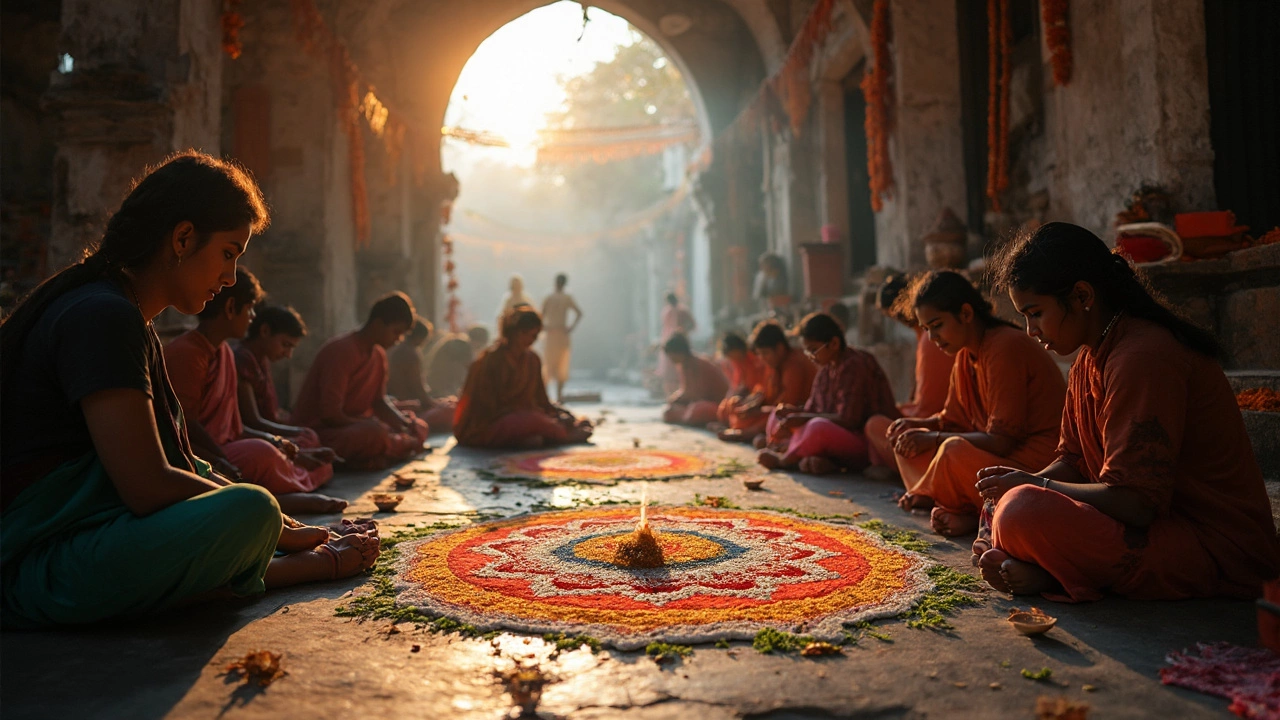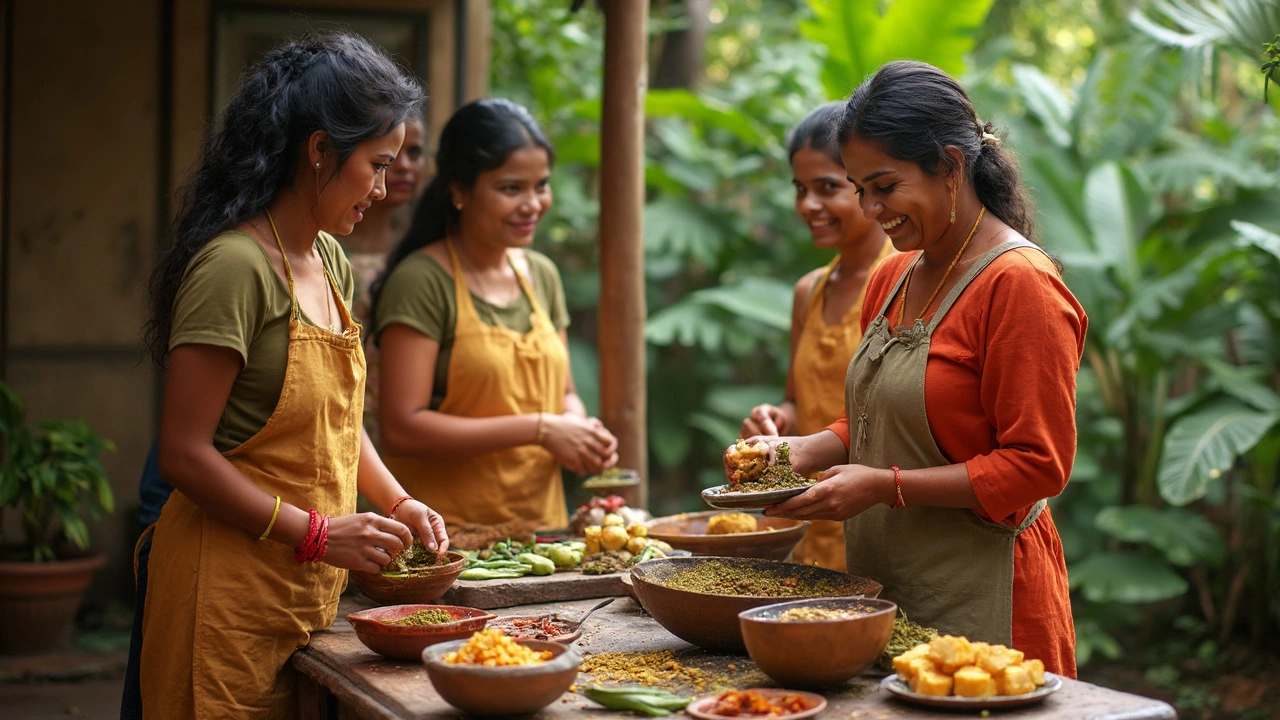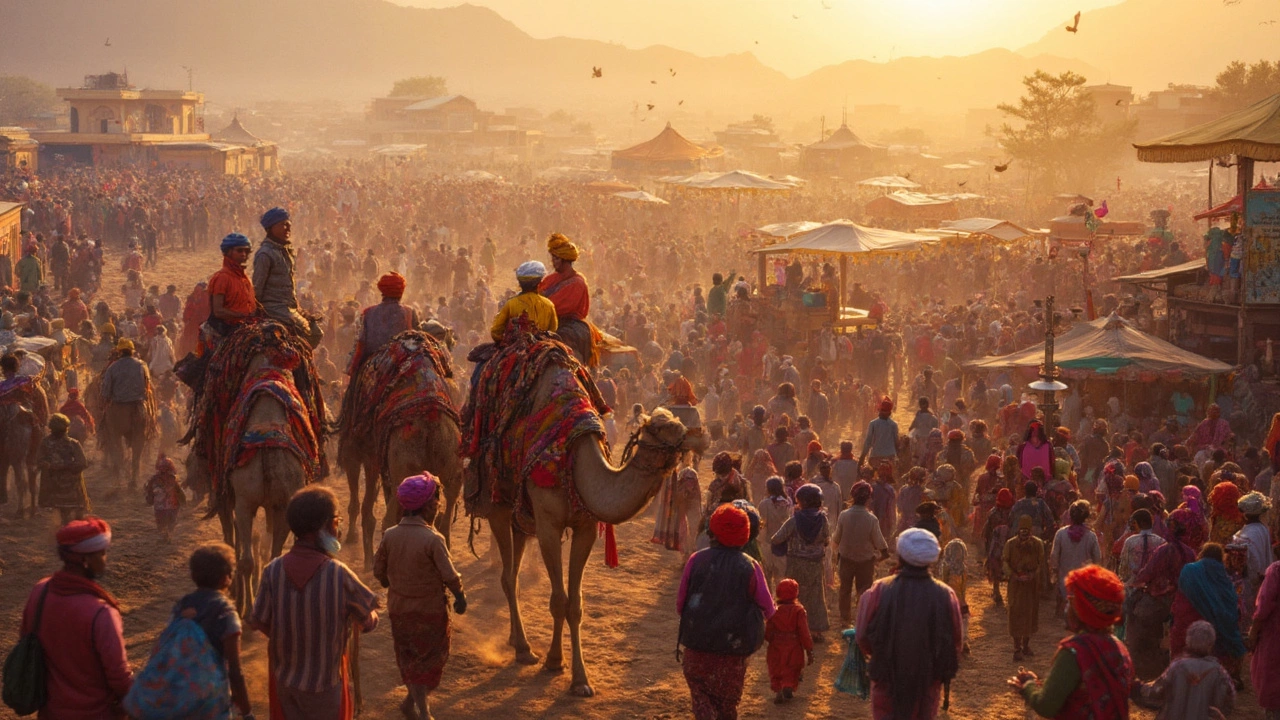If you want to actually feel what Indian culture is like—not just see it from a bus window—there’s a ton you can do that goes way beyond visiting the Taj Mahal. Cultural tourism in India means rolling up your sleeves and getting involved, whether that’s watching Holi colors fly in the streets, learning to cook biryani at someone’s home in Hyderabad, or weaving fabric with village artisans in Kutch.
Most travelers miss the real stuff because they stick to the obvious routes. So if you’re after real connection, think about joining a local festival, trying a craft workshop, grabbing food where the locals eat, or even staying the night at a family’s place out in the countryside. Every state in India has its own way of doing things, so you won’t run out of options. Ready for details? Handy ideas and spots are just ahead.
- Festivals Beyond the Obvious
- Living History: Famous Monuments and Offbeat Sites
- Art and Craft: Where Tradition Meets Today
- Food Trails: Eating Like a Local
- Staying With Culture: Homestays and Community Experiences
Festivals Beyond the Obvious
When most folks think of Indian festivals, Diwali and Holi are the first that come up. But there’s a whole other level of celebration happening across the country that barely makes it into travel ads. If you want to see the real flavor of Indian life, hunt out smaller, unique events where you’re less likely to run into other tourists snapping photos.
Take the Hornbill Festival in Nagaland as an example. This celebration brings together tribes from across the state each December. You see traditional war dances, hand-made tribal jewelry, and there’s a ton of food you won’t find anywhere else in India. The coolest part? It’s a crash course in Naga culture in just ten days. Or try the Pushkar Camel Fair in Rajasthan, which isn’t just about camels (though there are thousands). There’s live music, wrestling matches, and even a competition for the best mustache. No joke—locals take this contest super seriously.
If music is your thing, Ziro Festival in Arunachal Pradesh is an outdoor music festival set in rice fields, not city parks. Bands play everything from Indian folk to indie rock, all with the backdrop of mountains. For pure visual overload, there’s the Thrissur Pooram in Kerala, with rows of elephants decked out in gold and a fireworks show that goes all night. Each year, about 1 million people pack into the city for the event, but it’s still off the radar for most international tourists.
Many of these festivals are timed with the agricultural calendar or local religious legends, so they usually come with food stalls selling things you’ve genuinely never tasted. You might have to plan in advance, though, because some small-town celebrations (like Hemis in Ladakh) book up months ahead for homestays and guesthouses.
- Always check exact festival dates—they usually change each year based on the lunar calendar.
- Pack earplugs if you value sleep; even village festivals can be loud all night.
- Be respectful with photos. Many rituals are sacred, so ask someone if in doubt.
- Try local street snacks—think less "fancy restaurant" and more "life-changing samosa."
| Festival | State | Month | Main Attraction |
|---|---|---|---|
| Hornbill Festival | Nagaland | December | Tribal dances, food, crafts |
| Ziro Music Festival | Arunachal Pradesh | September | Outdoor concerts, camping |
| Thrissur Pooram | Kerala | April/May | Decorated elephants, fireworks |
| Pushkar Camel Fair | Rajasthan | November | Camel trading, contests, folk shows |
| Hemis Festival | Ladakh | June/July | Buddhist dances, monastery rituals |
If you're serious about cultural tourism India, tracking down these festivals gives you stories nobody else back home has. Just don’t be shy—locals love explaining what’s happening if you show some curiosity.
Living History: Famous Monuments and Offbeat Sites
It’s one thing to see photos of India’s sights. It’s a whole different game to stand inside ancient forts, hike through forgotten cities, or wander living neighborhoods with centuries-old stories. While the Taj Mahal is the superstar, this country is loaded with places that bring history to life for anyone who cares enough to look closer.
The big hitters like the cultural tourism India must-see Taj Mahal, Jaipur’s palaces, and Delhi’s Red Fort have postcard looks and wild backstories. For example, over 7 million people visit the Taj every year, soaking in that white marble and the love story behind it. But here’s a secret: some of the best experiences come from heading a little off the well-worn tourist snap trail.
- Hampi – Once the heart of a powerful empire, Hampi’s ruined temples and boulder fields in Karnataka feel like you’ve time-traveled. The place is still dotted with working shrines and local markets.
- Orchha – Not far from the middle of India in Madhya Pradesh, Orchha’s forts, palaces, and riverside domes see way less crowd, but you can watch locals using the riverbanks for festivals and rituals.
- Chand Baori – This stepwell in Abhaneri, Rajasthan, spirals 13 stories deep. It’s an engineering marvel built over 1,000 years ago where you won’t compete for space with selfie sticks.
- Chettinad Mansions – In Tamil Nadu, you’ll find old palatial homes with grand halls and hand-painted tiles, often open for tours, sometimes stays. The stories here are tied to trade and tradition.
- Kumbhalgarh Fort – Rajasthan’s wall runs over 36 km, second only to the Great Wall of China in length. The view at sunset is wild, and there’s tons of history to soak up without elbowing through crowds.
If you’re keeping track, here’s how some of these places stack up in real numbers:
| Monument/Site | State | Annual Visitors (approx.) | Special Tip |
|---|---|---|---|
| Taj Mahal | Uttar Pradesh | 7 Million | Go at sunrise to beat queues |
| Hampi | Karnataka | 500,000 | Stay overnight—temples light up at dusk |
| Orchha | Madhya Pradesh | 200,000 | Catch an evening aarti on the river |
| Kumbhalgarh Fort | Rajasthan | 150,000 | Don’t miss the fort’s light-and-sound show |
Most of these offbeat sites let you get close to real, local life—think chatting with shopkeepers, seeing age-old crafts, or catching tiny dramas playing out in temple courtyards. If you want to experience history, don’t just read the plaques. Strike up a conversation with someone selling chai, join a local festival, or ask about the stories that don’t make it into guidebooks. That’s when India’s past and present start to make sense together.

Art and Craft: Where Tradition Meets Today
One of the best ways to get inside cultural tourism India is to do something hands-on. Forget just shopping for a souvenir. Across the country, you can actually learn skills that have been passed down for centuries—and many of these traditional crafts are still the backbone of whole communities. Plus, it’s way more interesting than checking out a factory or a museum for an afternoon.
Think about block printing in Jaipur. This is where you can watch artisans carve intricate wooden blocks and then stamp bright designs onto cloth, all by hand. You’ll see how each print takes time and care—the same process families have used here for generations. Some spots, like Bagru village just outside Jaipur, run workshops where anyone can try their hand at it. You wear an apron, pick your colors, and print your own scarf or towel to take home. It’s low-pressure but you leave with a legit piece of your own making.
If fabric’s not your thing, there’s pottery in Khurja (Uttar Pradesh), Pattachitra painting in Odisha, and Madhubani art in Bihar. In Rajasthan, you’ll even find entire villages like Nimaj or Shilpgram set up for tourists to meet craftspeople and join quick workshops. And this isn’t just a sideshow—more than 7 million Indian households still depend on crafts and handlooms for their main income.
| Craft | Location | Activity |
|---|---|---|
| Block Printing | Jaipur, Rajasthan | Workshops, Hands-on Printing |
| Pattachitra Painting | Raghurajpur, Odisha | Guided Painting Sessions |
| Blue Pottery | Khurja, Uttar Pradesh | Pottery Making & Glazing |
| Madhubani Art | Madhubani, Bihar | Art Classes with Master Artists |
| Kutch Weaving | Bhuj, Gujarat | Weaving Demonstrations & Tryouts |
Buying directly from the artists not only gets you something authentic, it supports real families and keeps traditional know-how alive. If you care about being a responsible traveler, check for state-run handicraft centers or community co-ops. They usually have signs up, and there’s zero hard selling. Your money actually makes a difference here.
Here’s a bonus tip: certain festivals or art fairs, like the Surajkund Crafts Mela (held every February near Delhi), bring together hundreds of artisans from across India. It’s like a giant open-air workshop—perfect if you want to see lots of different styles, try your hand at a few crafts, and snack on local food all in one place.
Food Trails: Eating Like a Local
Nothing gets you into the heart of Indian culture like food. Street food tours in India aren’t just for your taste buds—they’re the real window into daily life, habits, and family secrets passed down through generations. Skipping the hotel buffet and joining a crowd at a popular local joint will teach you more than any guidebook.
If you find yourself in Delhi, follow your nose to Chandni Chowk. This old market is legendary for chaat (savory snacks), jalebi (sweet spirals), and parathas stuffed with everything from potato to paneer. A quick tip: go early, and never shy away from a queue—locals line up for a reason.
Down south, Hyderabad’s Laad Bazaar draws food lovers for its biryani, but skip fancy restaurants and track down a tiny eatery where office workers eat lunch. The taste is deeper, and you’ll probably eat with your hands—totally normal here! In Kolkata, try puchkas (tangy water-filled snacks) from a street vendor, or grab a plate of fish curry in a corner canteen—you can spot these by the heavy steel plates and people eating fast so they aren’t late for work.
- Always ask what’s most popular with locals, not just on menus or tourist apps.
- Try eating in a local home through cooking experiences or stay with a host family. In Kerala, you can book a homestay where you’ll shop for spices at a village market and cook with the family—fresh coconut chutney is a must.
- Keep cash handy—not all places accept cards, especially street stalls.
- Vegetarians have it easy: almost half of India’s population eats vegetarian, so you’ll find plenty of options everywhere.
Curious about how much food can say about a place? Here’s a quick snapshot:
| City/Region | Signature Dish | Best Place to Try |
|---|---|---|
| Delhi | Chaat | Chandni Chowk street vendors |
| Hyderabad | Biryani | Small local canteens around Charminar |
| Amritsar | Amritsari Kulcha | Roadside dhabas near Golden Temple |
| Kolkata | Puchkas | Victoria Memorial area street stalls |
| Jaipur | Dal Baati Churma | Family-run restaurants in old city |
This is more than just tasting food; it’s a crash course in how Indians celebrate, work, and unwind. The energy at a busy mithai (sweet shop) during Diwali, the ritual of chai at a tiny roadside stand, or the sizzle from a dosa truck in Bangalore all tell stories. Next time you plan your trip, skip generic spots—follow the smell, the queue, and the noise. That’s how you unlock cultural tourism India at its absolute best.

Staying With Culture: Homestays and Community Experiences
If you ever wondered what it’s like waking up to homemade chai or getting invited to a simple wedding in a tiny village, homestays in India make those moments possible. They’re way more than just places to crash. A good homestay sticks you right in the middle of real life, letting you swap travel-y chit-chat for honest conversations with the people who actually live there.
The cool thing? There are homestays all over India, each with a different flavor. For example, in Nagaland in the Northeast, staying with Naga families lets you try smoked pork, catch local music sessions, and see tribal customs up close. Head south, and a traditional houseboat stay on Kerala’s backwaters isn’t just for tourist selfies—the family often cooks the meals, tells you about fishing, and sometimes even takes you along to the market. In Himachal Pradesh, a homestay in Spiti means waking up surrounded by cold mountains, sharing butter tea, and possibly volunteering at a local monastery school for a day.
Community-based tourism projects deserve a mention, too. The Hodka village in Gujarat is run by locals who offer mud-hut stays, workshops in mirror work embroidery, and even night safaris into desert areas. In Ladakh, some villages have banded together to run eco-camps, giving you mountain life without trashing the place. The money you spend usually stays in the community—it’s a win-win.
If you decide to try a cultural tourism India experience through homestays or community tourism, here’s how to get the most out of it:
- Don’t expect hotel-style service—go with the flow about food, schedules, and comforts.
- Ask questions (people love sharing their traditions if you show interest).
- Respect house rules, especially about shoes, food, or prayer times.
- Bring a small gift from home—maybe local candy or kitchen tools. It’s a genuine icebreaker.
Lots of legit sites, like India Homestay or NotOnMap, now match travelers with screened hosts, so you don’t have to gamble. If you want an eye-opener, skip the boutique hotel one night and live, eat, and laugh alongside real families—you’ll walk away with way more than just cool photos.
